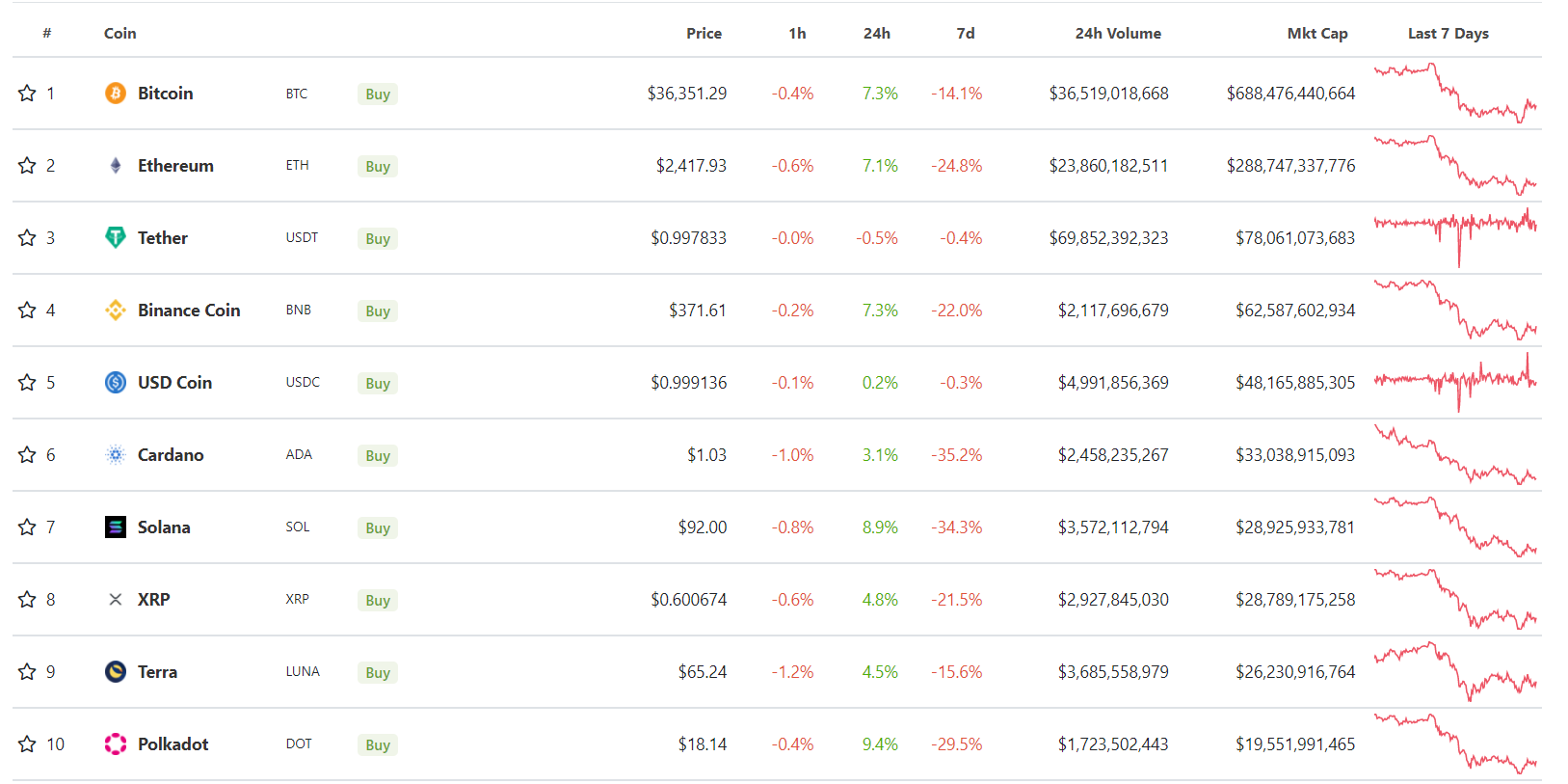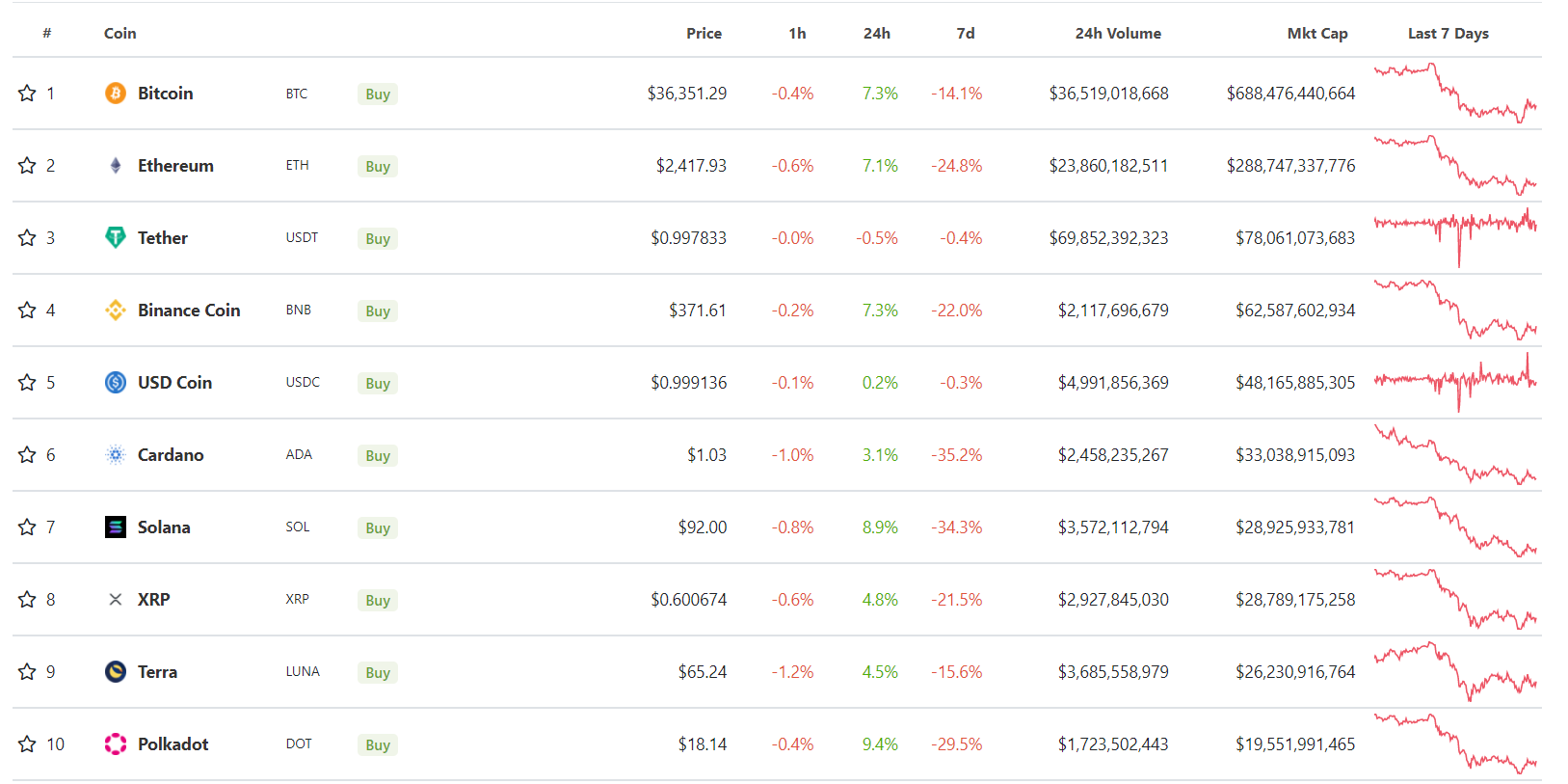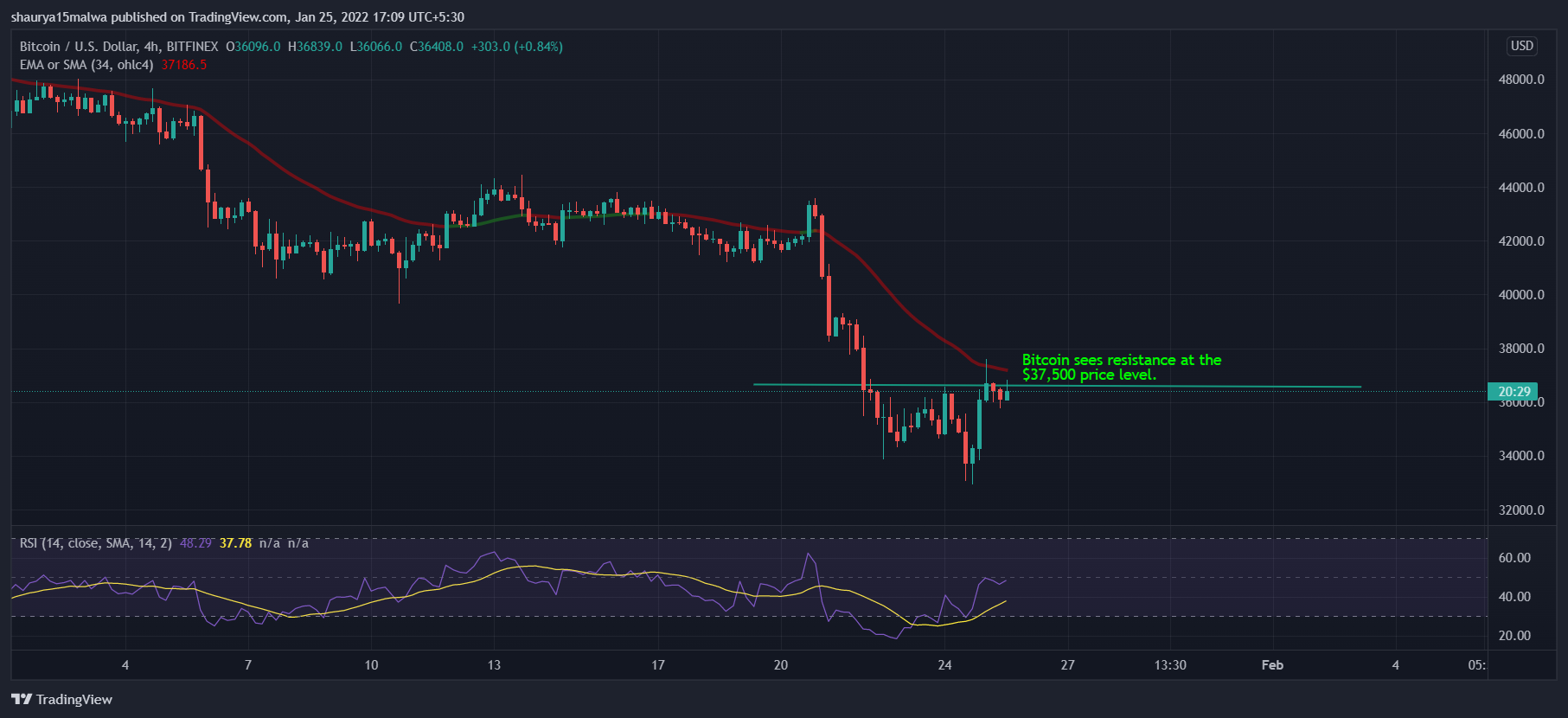Crypto markets staged a brief recovery ahead of Wednesday’s Federal Reserve meeting.

Bitcoin gained 10% in the past 24 hours to trade above $36,500 during European hours on Tuesday, staging a recovery after a plunge on Monday saw prices fall to as low as $33,500.
The move caused a resurgence in the broader crypto market, adding 5% to the $1.7 trillion total market capitalization in the past 24 hours. Several major cryptocurrencies rose as high as 12%, with DOT, SOL and ADA among the biggest gainers.

The recovery in the crypto market comes ahead of a U.S. Federal Reserve meeting on Wednesday, one that’s widely expected to reveal the agency’s stance on a rate hike in March. The Fed previously stated it would tighten monetary policy with up to four rate hikes in 2022 to keep inflation in check, causing a sell-off in asset markets across the globe during the last few months.
Cryptocurrencies have acted as a risk asset in the broader financial market similar to technology stocks. A tightened policy could see investors choose safer assets, which could, in turn, lead to a further drop in cryptocurrency prices.
“Crypto coins and tokens have been shown to be highly sensitive to equity prices, propelled upwards on a wave of cheap and easy money,” explained Susannah Streeter, markets analyst at financial services firm Hargreaves Lansdown, in a note on Tuesday.
“Hopes that bitcoin would act as an inflation hedge have fast evaporated, losing more than half its value since its November high, as consumer prices have soared,” Streeter added. “There may be speculators waiting in the wings to buy the big dip, but expect the volatility to continue as money liquidity washing around financial markets evaporates.”
Some macro traders say institutional capital in cryptocurrency markets has changed the overall market dynamic, and that it may not see the infamous boom and bust cycles as before.
“The determination of a bull/bear market is not as clear as previous cycles, due to the structure of the market changing drastically with institutions entering the space,” said Marcus Sotiriou, an analyst at crypto broker GlobalBlock, in a mail to CoinDesk. “It is apparent that bitcoin is in a ranging environment (between $29,000 to $69,000 approximately) rather than a trending environment.”
Bitcoin (BTC) rose to as high as $37,500 on Monday night before a sell-off to the $35,700 level during Asian morning hours on Tuesday. Prices of the world’s largest cryptocurrency by market capitalization are now down 30% in the past month and nearly 50% since May 2021’s peak of $69,000.
Readings from the Relative Strength Index (RSI), a price-chart indicator, for bitcoin hovered at the 50 mark during European hours on Tuesday, recovering from oversold levels of under 30 on Sunday. RSI calculates the magnitude of price movements for assets, with readings below 30 indicating prices of an asset have fallen further than its fundamental value.
RSI levels rose above oversold territory while bitcoin saw rejection from the $37,500 level. (TradingView)
Meanwhile, some analysts say Tuesday’s rally could prove to be short-lived for bitcoin investors.
“Rebound in bitcoin and the positive dynamics of the crypto market are more correctly attributed to technical factors: crypto investors are exiting altcoins to more liquid BTC, forming temporary bounces, but nothing more,” shared Alex Kuptsikevich, senior financial analyst at FxPro, in a mail to CoinDesk.
Kuptsikevich added bitcoin could retest 2021’s price lows instead of surging, “The nearest target for BTC downside is $32.3K to close the gap entirely. However, it is worth being prepared to retest the July lows of $29.5K-$30K.”
Further caution is still on the cards for bitcoin investors. “Without support from the stock markets, these levels may not hold for long either,” noted Kuptsikevich.
DISCLOSURE
The leader in news and information on cryptocurrency, digital assets and the future of money, CoinDesk is a media outlet that strives for the highest journalistic standards and abides by a strict set of editorial policies. CoinDesk is an independent operating subsidiary of Digital Currency Group, which invests in cryptocurrencies and blockchain startups. As part of their compensation, certain CoinDesk employees, including editorial employees, may receive exposure to DCG equity in the form of stock appreciation rights, which vest over a multi-year period. CoinDesk journalists are not allowed to purchase stock outright in DCG.
“Crypto coins and tokens have been shown to be highly sensitive to equity prices, propelled upwards on a wave of cheap and easy money,” explained Susannah Streeter, markets analyst at financial services firm Hargreaves Lansdown, in a note on Tuesday.
“Hopes that bitcoin would act as an inflation hedge have fast evaporated, losing more than half its value since its November high, as consumer prices have soared,” Streeter added. “There may be speculators waiting in the wings to buy the big dip, but expect the volatility to continue as money liquidity washing around financial markets evaporates.”
Some macro traders say institutional capital in cryptocurrency markets has changed the overall market dynamic, and that it may not see the infamous boom and bust cycles as before.
“The determination of a bull/bear market is not as clear as previous cycles, due to the structure of the market changing drastically with institutions entering the space,” said Marcus Sotiriou, an analyst at crypto broker GlobalBlock, in a mail to CoinDesk. “It is apparent that bitcoin is in a ranging environment (between $29,000 to $69,000 approximately) rather than a trending environment.”
Bitcoin (BTC) rose to as high as $37,500 on Monday night before a sell-off to the $35,700 level during Asian morning hours on Tuesday. Prices of the world’s largest cryptocurrency by market capitalization are now down 30% in the past month and nearly 50% since May 2021’s peak of $69,000.
Readings from the Relative Strength Index (RSI), a price-chart indicator, for bitcoin hovered at the 50 mark during European hours on Tuesday, recovering from oversold levels of under 30 on Sunday. RSI calculates the magnitude of price movements for assets, with readings below 30 indicating prices of an asset have fallen further than its fundamental value.

Meanwhile, some analysts say Tuesday’s rally could prove to be short-lived for bitcoin investors.
“Rebound in bitcoin and the positive dynamics of the crypto market are more correctly attributed to technical factors: crypto investors are exiting altcoins to more liquid BTC, forming temporary bounces, but nothing more,” shared Alex Kuptsikevich, senior financial analyst at FxPro, in a mail to CoinDesk.
Kuptsikevich added bitcoin could retest 2021’s price lows instead of surging, “The nearest target for BTC downside is $32.3K to close the gap entirely. However, it is worth being prepared to retest the July lows of $29.5K-$30K.”
Further caution is still on the cards for bitcoin investors. “Without support from the stock markets, these levels may not hold for long either,” noted Kuptsikevich.
Coindesk